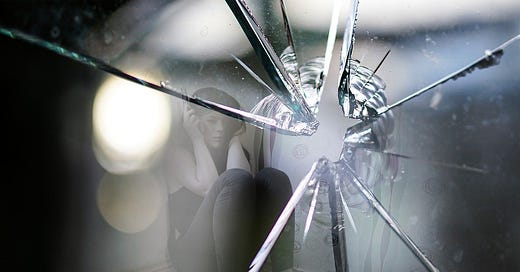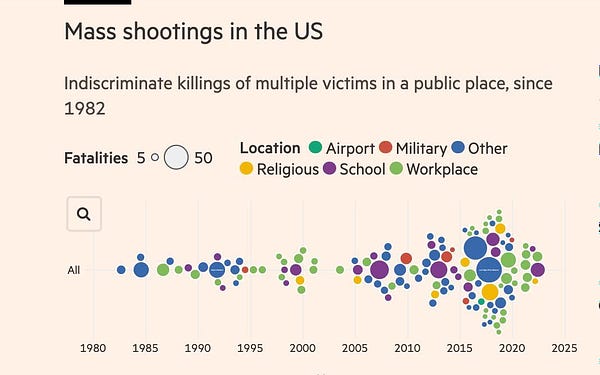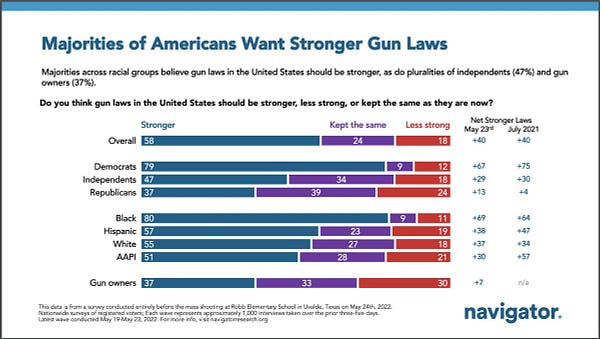Why America Must Prepare For a Decades-Long War Over “Gun Control”
Right now with guns we’re at the point where advocates for gay marriage were in the 1990s when it seemed impossible...
Democrats are gearing up for quick policy battles in the House and Senate over “gun safety.” They should also be preparing for a decades-long war over “gun control.”
In 1977, Harlan Carter and a group of his friends staged a coup within the senior ranks of the NRA, flipping it from a gun-safety-oriented sportsman’s club into a “no compromise” (Carter’s phrase) lobbying and PR group for the gun industry.
Carter was the perfect man for the job of filling America with guns, championing the slaughter of schoolchildren, and amping us up to around 45,000 gun deaths a year — more than any other nation on Earth — as he had shot and killed a 15-year-old Hispanic boy, Ramón Casiano, when Carter was himself only 17 years old.
He loved guns and sure knew what they could do in the hands of a pissed-off white boy.
The year after Carter took over the NRA, the Supreme Court, in an opinion authored by Lewis Powell himself, ruled in the Boston v Bellotti case that a corporation (like the NRA) was entitled to “personhood” and thus could claim the human rights spelled out in the Bill of Rights, including the First Amendment right to “free speech.” That speech could take the form of campaign cash and other monetary support, the Court ruled.
Those two years and two events began the modern “product cycle” of the gun crisis in the United States.
I came up in the advertising business in the 1970s and 1990s, having been a partner and founder in two ad agencies and taught communications, advertising, and marketing worldwide for government agencies from the NSA and CIA to employees of over 100 of the Fortune 500 companies through The American Marketing Centers in the 1990s. Understanding product cycles is at the foundation of advertising 101.
An example of a product cycle most everybody knows, even if they don’t realize it in this context, is cigarettes.
In 1964, the US Surgeon General released an explosive report on the health impacts of smoking, laying hundreds of thousands of unnecessary deaths every year at the feet of that industry. The tobacco lobby fought it with everything they had, while simultaneously exploiting it with “healthier” filter cigarettes.
Out of that report came hundreds of anti-smoking groups across the country, all dedicated to reducing the unnecessary deaths that grotesque industry was inflicting on Americans for profit.
In 1986 one of the top fine dining restaurants in the country, The Pillar House in Boston, went 100% smoke-free. It was a milestone and, while the business media was predicting bankruptcy, that restaurant and others doing the same thrived.
In 1998 the tobacco industry promised in a court settlement to stop marketing to children, although a court found in 2006 that they were still doing it (as they are today, albeit less directly).
It took until 2000 for smoking to be legally banned on all flights within, to, and from the United States.
Eventually city after city, state after state banned cigarette vending machines; they were outlawed nationwide in 2010, and by that time most schools had adopted some sort of anti-smoking education programs.
Tobacco is one of only two products sold in the United States that produces death “when used as directed.” The other, of course, is guns.
With guns, we are just now entering a major shift — the first since 1978 — in that product’s cycle. When we understand that, we understand the magnitude of the work ahead of us, if we’re really going to stop mass shootings.
This is going to require a revolution against an established order, and revolutions require revolutionaries. People willing to speak blunt truths, to draw stark lines, to lead public opinion rather than follow it.
Right now Democratic strategists are cautioning us not to be “too radical,” to avoid using the phrase “gun control” in favor of the less controversial “gun safety,” and to content ourselves with tiny incremental changes like closing the gun-show loophole.
That’s BS, and we need to call it out for what it is. Democrats have to stop negotiating with themselves and start fighting.
The weapons industry and the gun fetishists they’ve indoctrinated are already on war footing; they’ve been there since 1978. They have no interest in compromise and — no matter what we call our efforts — they’ll scream “gun control!” so loud it’ll be heard in every corner of the nation.
They’re itching for a fight and being nice will just mean certain defeat.
Other products have gone through this sort of cycle, and we must remember what a fight each represented if we’re to soberly consider the battle ahead of us.
When Rachael Carson published Silent Spring in 1962, the DDT and pesticide industry went to war; it took the near-extinction of the American Bald Eagle and more than a decade to rid our nation of that terrible chemical that was once routinely sprayed from airplanes across cities and suburbs. There were setbacks: the tobacco industry, a heavy user, nearly got DDT re-authorized for US use in the 1990s.
When Ralph Nader wrote Unsafe At Any Speed in 1965, the auto industry went to war; it took decades (and hundreds of thousands of deaths) before the industry finally was forced to embrace seat-belts, collapsible steering wheels, airbags, anti-lock brakes and other now-standard safety features.
Right now with guns we’re at the point my friend who owned that Boston restaurant was at back in the early smoking wars of the 1980s. Or where advocates for gay marriage were in the 1990s when it seemed impossible.
We’re the “early adopters” of public opinion with regard to gun control.
We’re the ones willing to say that we think owning a gun should at least carry the same “regulation” as owning and driving a car (which can also kill people): it must be registered, you must obtain a license by proving proficiency on a gun range and passing a written exam about safety and the law, and you must have liability insurance.
We must be willing to say out loud that we want to see all assault weapons and, indeed, all non-hunting-specific semi-automatic weapons — weapons specifically designed to kill human beings in a theater of war — removed from civilian hands in the United States.
We must proudly point out that states with strong gun control laws — like Massachusetts, which has only seen 2 children die in school shootings in decades — have fewer gun deaths. Or that nations like Canada and most of Europe, where guns are available but well-regulated, have only a tiny fraction of the gun deaths and injuries we experience here in America.
We must point out that “a good guy with a gun” stopping “a bad guy with a gun” is a stupid trade-off and that, as I lay out in detail in my book The Hidden History of Guns and the Second Amendment, it’s a complete lie that the Founders wanted us to be armed so we could “overthrow a tyrannical government.”
We should respect hunters (particularly in poor rural areas) and sport shooters, but express only a morbid curiosity about people who choose to have guns around their houses “just in case” they ever need them. Keeping guns around the house to “deter crime,” with a few geographic exceptions, is like carrying a 5 gallon can of gasoline in the back seat of your car everywhere you go “just in case”: it’s more likely to kill you than to save you.
We must point out the simple reality that if you live in an area with a lot of ticks you’re more likely to get Lyme Disease; if you live in an area with a lot of rattlesnakes you’re more likely to end up snakebit; if you live in an area with a lot of guns you’re more likely to get shot.
We must be willing to ask, “What the hell happened to common sense?”
And we must know that every step we take will be attacked in bad faith by the NRA and their Republican allies as “not having solved the problem.” Nonetheless, we must persevere.
It's taken over 50 years for America to go from a “normal” number of guns and our first mass shooting in 1966 to the orgy of guns and killings that exploded on the American scene when the Bush administration and Republicans in Congress let the Assault Weapons Ban expire in 2004.
Along the way there have been hundreds of pro-gun changes to the laws, both state and federal, from both legislatures and courts, as well as changes in public opinion.
Reversing forty years of pro-gun momentum will take a similar multi-decade campaign, one law and court challenge at a time. We can’t let ourselves get discouraged at the inevitable setbacks along the way.
Today we’re at the cusp of real and lasting change, whether it happens in Congress this year, as the result of massive voter turnout this November, or in 2024.
If there was ever a time for us to speak boldly with the courage of our convictions, this is it.








I’m listening to Thom’s program now. I think one point that is not mentioned often is that the 223 round that the AR15 fires travels at three times the velocity of more normal 45 or 9mm rounds. The 223 was developed by the military to do maximum injuries to opponents. It totally destroys tissue and organs. It is a military round not a hunting or target round. Just based on their original design, they should be totally banned (weapon platform as well) from being sold to the general population
Non-Lethal Technology along with Gun Control:
As Thom points out it could be a decades long war to get gun control and even then there will still be killers with access to guns. We should use or develop non-lethal means to stop a shooter that wouldn’t kill other people.
Sleeping gas – exploding canisters of sleeping gas could be fired in the general direction of the shooter. After capture, an antidote could be administered to everyone breathing the gas.
Dazzler – temporarily blinds or disorients the shooter with intense radiation (rifle-like devise) see Wikipedia for more info under non-lethal weapons.
Skin Penetrating Tranquilizer Grains with Antidote – fired by a shotgun like devise with a very wide pattern as to more easily hit shooter could possibly be developed.
Bear Spray, Tasers and Pepper Balls fired by paintball guns could also be used.
People would likely prefer a non-lethal weapon in which nobody would be accidentally killed or if the weapon gets the wrong hands, it couldn’t be used to kill. An effective non-lethal weapon that automatically dials 911 when used, could be widely owned but only used in emergency situations. So possibly, a teacher could just point and pull a trigger; a shooter would be knocked-out with police and first responders on the way.
We should have funds going to research and development of non-lethal weapons and an ongoing study to determine the most effective non-lethal weapons for different situations.
Background checks, bans on some firearms, registering firearms and having a license to have a gun with insurance should be a goal, but getting non-lethal weapons available as soon as possible should be a priority. We need to use technology to help solve this very tragic problem as soon as we can.
Thank you,
Doug